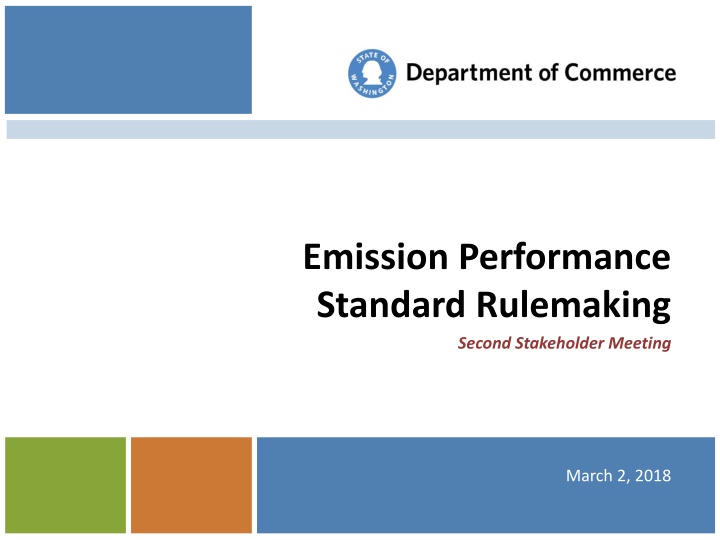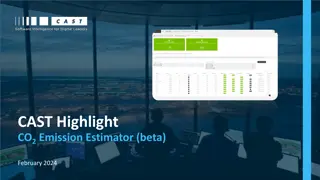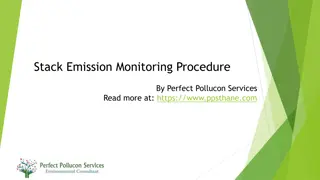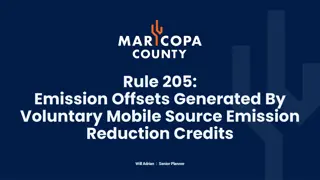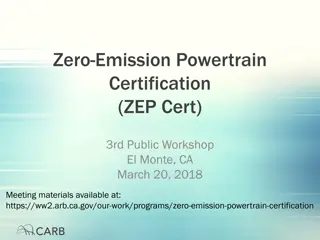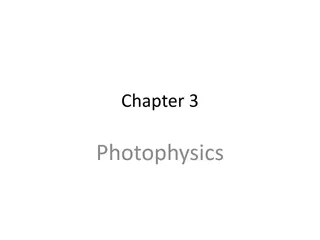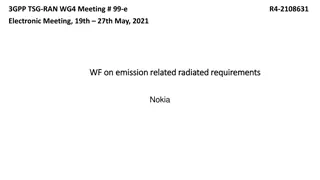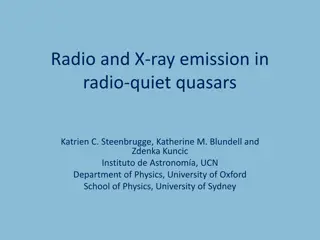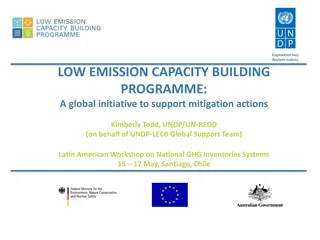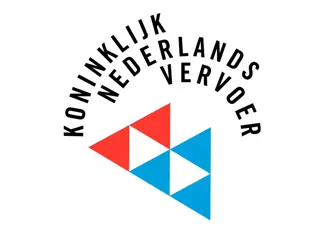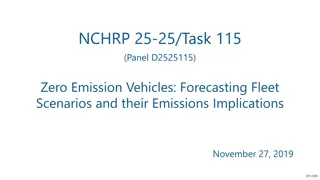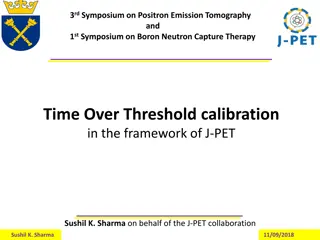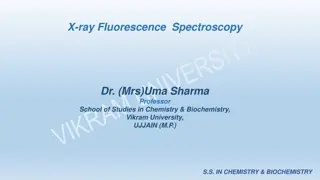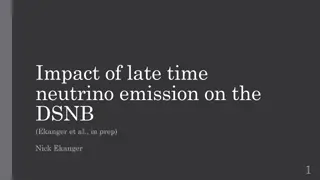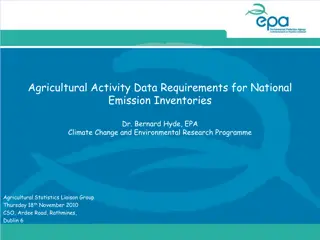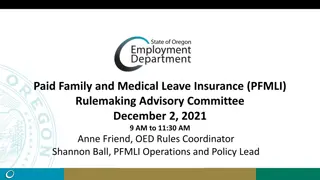Emission Performance Standard Rulemaking
Stakeholders meet to discuss the development of the Washington State Emission Performance Standard, including methodology, EPA calculator, GHG emissions factors, and survey results of CCCT installations. Manufacturers such as General Electric, Siemens, and Mitsubishi among others are highlighted.
Download Presentation

Please find below an Image/Link to download the presentation.
The content on the website is provided AS IS for your information and personal use only. It may not be sold, licensed, or shared on other websites without obtaining consent from the author.If you encounter any issues during the download, it is possible that the publisher has removed the file from their server.
You are allowed to download the files provided on this website for personal or commercial use, subject to the condition that they are used lawfully. All files are the property of their respective owners.
The content on the website is provided AS IS for your information and personal use only. It may not be sold, licensed, or shared on other websites without obtaining consent from the author.
E N D
Presentation Transcript
Emission Performance Standard Rulemaking Second Stakeholder Meeting March 2, 2018
Agenda Introductions Approach to develop the WA Emission Performance Std. Summary of recent EPS work 2018 EPS calculator results Compare proposed EPS with existing NW CCCTs Comments Rulemaking timeline Adjourn Washington State Department of Commerce
Approach to Develop the WA Emission Performance Standard We followed the approach developed during the 2012/13 rulemaking: Objective: To develop a real world emission performance standard (EPS) Surveyed recent U.S. purchases/installs of combined cycle combustion turbines (CCCTs), using a five-year look back period. Collected published heat rate (Btu/kwh) values for the CCCTs in the survey. These are hypothetical clean and new heat rates (HR) Washington State Department of Commerce
Approach to Develop the WA EPS (cont.) 2012/13 methodology (cont.) State and Technical Group members researched and developed heat rate adjustment factors to convert a clean and new HR to real world heat rate Developed an EPS calculator that stepwise applies the agreed upon HR adjustment factors creating a proposed WA emission performance std. Presented the proposed WA EPS to the larger stakeholder group for review and comments Washington State Department of Commerce
Function of the EPS Calculator Converts heat rate to emission rate: Determine final adjusted heat rate for all CCCT configurations and multiply by the natural gas emission factor to arrive at an emission rate of pounds CO2 per MWh for all CCCTs. Includes other GHG gases: Add standard values (lb./MWh) for methane and nitrogen oxides emissions based on Department of Ecology reports. Average emission factor: Averages across all CCCT models and configurations to arrive at the average GHG emission factor (the state updated EPS) for commercially available CCCTs. Washington State Department of Commerce
Summary of 2017/18 EPS Work 1. Survey of 2012-17 U.S. CCCT Installations Manufacturer and Model shares: 2012-17 Survey Total Manuf. shares EPS shares Manufacturer Model category Small/aero 5 F/G class 23 H/J class 3 31 40% 40% General Electric 29 38% 40% Siemens 2 19 8 17 22% 20% Mitsubishi 1 12 4 small/aero 8 10% 10% F class 54 70% 70% H class 15 19% 20% 77 100% 100% Survey Total Total % EPS shares
Summary of 2017/18 EPS Work(cont.) Details of subset of CCCTs used in the EPS calculator Class of CCCT count percent Manufacturer EPS count Aero/small Mid F/G Adv H/J Total 2 10% 70% 20% 100% General Electric Siemens Mitsubishi Total 8 8 4 14 4 20 20 2. Collected the clean and new heat rate values from Gas Turbine World for the most common CCCT models observed in the 2012-17 U.S. CCCT survey
Summary of 2017/18 EPS Work (cont.) 3. Convened a Technical Work Group to review, and when necessary, modify the HR adjustment factors used in the 2012/13 EPS calculator 4. Collected EPA and EIA fuel input and generation data for Pacific Northwest CCCTs for later evaluation of the EPS calculator
Summary of 2017/18 EPS Work (cont.) 5. Updated the EPS calculator with new CCCT heat rate data and modified heat rate adjustment factors creating the proposed new WA EPS 6. Present the proposed new WA EPS to stakeholders for review and comment
Updated 2018 EPS Calculator and the proposed standard Heat rate adj. for Climate and Inlet Cooling Fully Adjusted emission rate Gross clean and new heat rate Adjusted heat rate - net & ageing Heat rate adj. for stop/start/p artial load Adjusted heat rate w/ duct firing Manufacturer and model type Design year (not update yr) Nominal class (MB G equiv. to F) Plant format Net rated output Higher Heat Value Emission rate lb. GHG/MWh Theoretical efficiency Duct firing heat rate Theoretical efficiency (GT per ST) MW BtuLHV/kWh BtuHHV/kWh Efficiency BtuHHV/kWh BtuHHV/kWh BtuHHV/kWh BtuHHV/kWh BtuHHV/kWh percent lb. GHG/MWh General Electric F.03 F.04 F.04 F.05 F.05 HA.01 HA.02 LM2500+G4 Mitsubishi GAC GAC GAC J Siemens F F F F F F H SG800 Averages and totals 1023 913 913 904 904 880 866 1064 F F F F F H H 7,134 6,332 6,332 6,271 6,271 6,090 5,991 7,431 839 745 745 737 737 716 705 874 48% 54% 54% 54% 54% 56% 57% 46% 40% 45% 45% 45% 45% 47% 47% 38% 1979 2009 2009 2009 2009 2012 2014 2005 2x1 1x1 1x1 1x1 1x1 1x1 1x1 2x1 287 305 305 376 376 436 560 101 6439 5715 5715 5660 5660 5497 5408 6707 7,543 6,695 6,695 6,631 6,631 6,440 6,335 7,857 9,550 9,200 9,200 9,200 9,200 9,200 9,200 9,550 7,973 7,109 7,109 7,045 7,045 6,854 6,749 8,287 8,531 7,607 7,607 7,538 7,538 7,333 7,222 8,867 8,703 7,760 7,760 7,689 7,689 7,481 7,367 9,045 Aero 916 916 916 894 G G G J 6,354 6,354 6,354 6,197 747 747 747 729 54% 54% 54% 55% 45% 45% 45% 46% 2011 2011 2011 2011 1x1 1x1 1x1 1x1 412 412 412 470 5735 5735 5735 5594 6,719 6,719 6,719 6,553 9,200 9,200 9,200 9,200 7,133 7,133 7,133 6,967 7,632 7,632 7,632 7,455 7,785 7,785 7,785 7,605 935 935 935 935 935 935 897 981 F F F F F F H 6,496 6,496 6,496 6,496 6,496 6,496 6,216 6,819 764 764 764 764 764 764 731 802 53% 53% 53% 53% 53% 53% 55% 50% 44% 44% 44% 44% 44% 44% 46% 42% 1989 1989 1989 1989 1989 1989 2010 2010 1 X 1 1 X 1 1 X 1 1 X 1 1 X 1 1 X 1 1 X 1 2 X 1 370 370 370 370 370 370 460 144 5863 5863 5863 5863 5863 5863 5611 6155 6,868 6,868 6,868 6,868 6,868 6,868 6,573 7,211 9,200 9,200 9,200 9,200 9,200 9,200 9,200 9,550 7,282 7,282 7,282 7,282 7,282 7,282 6,987 7,640 7,792 7,792 7,792 7,792 7,792 7,792 7,476 8,175 7,949 7,949 7,949 7,949 7,949 7,949 7,627 8,339 Aero 5,827 6,456 759 53% 6,827 7,243 7,750 7,906 44.1% 930 Averages (Heat Rate or Efficiency)
Current and Proposed EPS and 2012-17 CCCT emissions Washington State Department of Commerce
Current Ch. 194-26 WAC: Proposed GHG Emission Performance Std. language Average available greenhouse gas emissions output. The energy policy division of the department of commerce has surveyed new combined-cycle natural gas thermal electric generation turbines commercially available and offered for sale by manufacturers and purchased in the United States, and finds the average rate of emissions of greenhouse gases for these turbines to be nine hundred and thirty pounds per megawatt- hour. Washington State Department of Commerce
For Comparison, the final 2012/13 EPS Calculator Heat rate adj. for stop/start/ partial load Heat rate adj. for Climate and Inlet Cooling Gross clean and new heat rate Adjusted heat rate - net & ageing Adjusted heat rate w/ duct firing Manufacturer and model Design year Nominal class Net rated output Duct firing heat rate Theoretical efficiency Emission rate lb. GHG/MWh Format Emission rate MW BtuLHV/kWh BtuHHV/kWh Efficiency BtuHHV/kWh BtuHHV/kWh BtuHHV/kWh BtuHHV/kWh BtuHHV/kWh percent General Electric 206FA S107FA S207FA S207EA 1991 2008 2008 1977 F F F E 2 X 1 1 X 1 2 X 1 2 X 1 239 277 542 270 6,132 5,948 5,889 6,695 6,794 6,590 6,524 7,417 799 775 767 872 50% 52% 52% 46% 7,184 6,968 6,899 7,843 9,750 9,400 9,400 9,750 7,646 7,414 7,344 8,305 8,104 7,858 7,785 8,804 8,267 8,016 7,942 8,981 42% 43% 44% 39% 972 943 934 1056 LM6000PF Sprint Mitsubishi 2006 Aero 2 X 1 123 6,408 7,099 835 48% 7,507 9,750 7,969 8,447 8,617 40% 1013 MPCP1(M501G) MPCP2(M501G) MPCP2(M501F) Siemens SGT6-8000H 2S 2008 2008 1994 G G F 1 X 1 2 X 1 2 X 1 399 800 572 5,843 5,823 5,955 6,473 6,451 6,597 761 759 776 53% 53% 52% 6,845 6,822 6,976 9,400 9,400 9,400 7,291 7,267 7,422 7,728 7,703 7,867 7,883 7,858 8,025 44% 44% 43% 927 924 944 2010 H 2 X 1 820 5,687 6,301 741 54% 6,662 9,400 7,108 7,534 7,686 45% 904 SCC6-5000F SCC6-5000F SCC6-2000E SCC-700 Averages and totals Averages (Heat Rate or Efficiency) 1989 1989 1989 1998 F F E 1 X 1 2 X 1 1 X 1 1 X 1 307 620 171 44 5,990 5,960 6,630 6,672 6,636 6,603 7,345 7,392 780 777 864 869 51% 52% 46% 46% 7,017 6,982 7,767 7,816 9,400 9,400 9,400 9,750 7,463 7,428 8,213 8,278 7,911 7,873 8,705 8,775 8,070 8,032 8,880 8,951 43% 43% 39% 39% 949 945 1044 1053 Aero 6,126 6,786 798 50% 7,176 7,627 8,084 8,247 42.3% 970 Delta H.R./Emissions Emission factor (lb/MWh) Std.Dev. (lb/MWh) 10.8% 798 46 5.7% 844 48 6.3% 897 49 6.0% 951 52 2.0% 970 53 21.5% 21.5% Number CCCTs 13
EPS Rulemaking Timeline March 2: Stakeholder EPS update Early March: File CR102 with Code Reviser Late March: CR102 published in WSR March-April: Comment period Late April: 3rd Stakeholder mtg April-early May: Respond to comments, adjust if necessary June: File CR103
Presented by: Greg Nothstein Energy Policy Specialist (360) 725-3112 greg.nothstein@commerce.wa.gov www.commerce.wa.gov/energy
